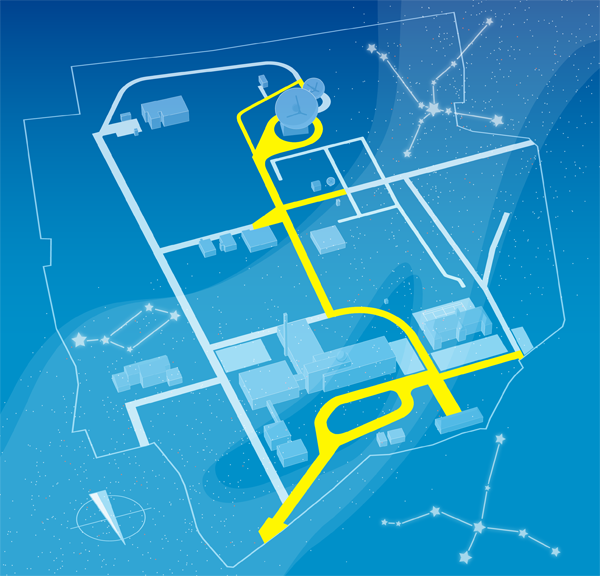Visit Campus

■Yellow : Walking Route
A booklet is available at OSAM. Opening hour is from 09:00 to 17:00.
Oshu Space and Astronomy Museum (OSAM; “Yugakukan” in Japanese)

The OSAM is a science museum run by Oshu city, which is located in the same Mizusawa campus. In OSAM, people in all range of ages can study the space and astronomy. The historical building of OSAM was used as the main building of the former International Latitude Observatory of Mizusawa, which was the predecessor institute of the Mizusawa VLBI Observatory.
The 4-dimensional digital theater “4D2U” (4-D to you!) created by NAOJ-4D2U project, and hands-on materials to experience sciences are regularly exhibited. Special exhibitions like state-of-the-art instruments by NAOJ and JAXA, as well as recent scientific results are also updated.
And, science cafes (scientific talks over some drinks), monthly stargazing parties, irregular scientific events and workshops are also scheduled. For more details, please contact to the following.
- Opening hour
- 09:00 - 17:00(admission by 16:30)
- Holidays
- Year-end/New-year holidays, Tuesday (next day if Tuesday is a national holiday)
- Admission
- 200 yens for adults, 100 yens up to high-school student (half price for a group more than 15 persons)
- phone
- 0197-24-2020
- website
- http://users.catv-mic.ne.jp/~yugakukan/index.html (in Japanese)
Must-to-see!

4D2U
Space travel with 3-dimension and time= 4-D !

Lunar 3-D model
Reproduction of the data of Laser altimeter aboard Kaguya lunar orbiter

Planet corner
Experience the difference of the force of gravity on Mercury, Venus, Earth, Mars, etc.

OSAM in the evening
The building in the twilight brings us to the old days of Mizusawa..
Kimura Hisashi Memorial Museum (Kimura Museum)

This is a memorial museum to honor Prof. Hisashi Kimura, the first director of the International Latitude Observatory of Mizusawa.
In this museum, the director’s room at the time is realized as it was. The visual zenith telescope (VZT), which was used to find the Z-term, historical telescopes for the elucidation of the Z-term, and the first Cultural Merit Medal and other treasures are displayed. One can listen to Kimura’s recorded voice.
Detailed description is made for the exhibition, aiming to people older than 10 years old. Visitors are encouraged to take enough time to read them through.
- Opening hour
- 09:00 - 17:00(admission by 16:30)
- Holidays
- Year-end/New-year holidays, Tuesday (next day if Tuesday is a national holiday)
- Admission
- free
- phone
- 0197-24-2020
- website
- http://www.miz.nao.ac.jp/kimura/ NEW!(in Japanese)
Must-to-see!

Bust of Dr. Kimura
The visual zenith tube room, which was in use, is located in the direction of his eyes.

Directors’ office
The abacus and slide rule which were used by Dr. Kimura are displayed.

Cultural Merit
The first Cultural Merit of Japan for contribution to astronomy with the finding of Z-term

VZT
The first VZT which Dr. Kimura used for observation. It was lent to Australian observation site.
Visual Zenith Telescope Building (VZT)

The latitude observations from 1899 to 1927 were carried out here.
The building was designed to provide optimal temperatures inside, with the use of the iron inside wall and the outside louver.
- Open
- 09:00 - 17:00
The 3-m antenna

The 3-m antenna was built as the first radio telescope, and used for test observations of radio astronomy at NAOJ Mizusawa Campus in 1987.
Very Long Baseline Interferometry (VLBI) opened the way to perform high-accuracy measurements of Earth rotation.
- Open
- 09:00 - 17:00
The 20-m antenna

VERA uses four 20-m antennas in Mizusawa, Iriki, Ogasawada and Ishigaki, spanning 2300 km in Japan.
VERA achieves the high angular resolution which would be given by a single dish which was 2300 km in diameter.
VERA is a Japanese VLBI array aimed for obtaining 3-dimensional map of the Milky Way galaxy. With VLBI technique, VERA measures distances and motions of radio sources in the Galaxy with unprecedentedly high accuracy, unveiling the true structure of the Galaxy.
- Open
- 09:00 - 17:00
Must See !

Azimuth wheel
Look at the snowplow to remove snow from the antenna azimuth rail.

Sunshade panels
It is designed to avoid rapid thermal expansion by the direct sunshine.

Receiver room
VERA's unique 2-beam receiver system is installed in a big receiver room.

Antenna in twilight
The VERA 20-m antenna is illuminated by low-pressure sodium lamp.
The 10-m antenna

The 10-m antenna, completed in 1992, operates at frequency bands of 2, 8, 22, 43 GHz.
It was mainly used one of the Japanese VLBI stations. Currently, it is used for developments of RISE, evaluations of VERA, and some observations with related to the VERA.
- Open
- 09:00 - 17:00
CSS not active
JavaScript not active